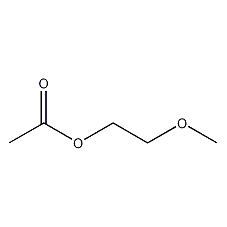2-Methoxyethyl acetate 2-Methoxyethyl acetate


Structural formula
| Business number | 031A |
|---|---|
| Molecular formula | C5H10O3 |
| Molecular weight | 118.13 |
| label |
Ethylene glycol monomethyl ether acetate, Ethylene glycol methyl ether acetate, Methyl cellosolve acetate, Ethylene glycol methyl ether acetate, Methylene glycol ether acetate, Ethylene glycol monomethyl ether acetate, Methyl cellosolve acetate, Methyl glycol acetate, CH3COOCH2CH2OCH3, Solvents for nitrocellulose spray paint and skin paint, Cellulose acetate solvent, aliphatic compounds |
Numbering system
CAS number:110-49-6
MDL number:MFCD00008719
EINECS number:203-772-9
RTECS number:KL5950000
BRN number:1700761
PubChem number:24858661
Physical property data
1. Properties: colorless liquid with a slight ether-like odor. [1]
2. Melting point (℃): -65.1[2]
3. Boiling point (℃): 143[3]
4. Relative density (water=1): 1.01 (20℃)[4]
5. Relative vapor density (air = 1): 4.07[5]
6. Saturated vapor pressure (kPa): 0.27 (20℃)[6]
7. Octanol/water partition coefficient: 0.121[7]
8. Flash point (℃): 45 (CC): 55.6 (OC)[8]
9. Ignition temperature (℃): 392[9]
10. Explosion upper limit (%): 12.3[10]
11. Explosion lower limit (%): 1.5[11]
12. Solubility: soluble in water and miscible in most organic solvents. [12]
13. Refractive index (20ºC): 1.4022
14. Refractive index (25ºC): 1.4025
15 .Viscosity (mPa·s, 20ºC): 1.08
16. Flash point (ºC, closed): 56
17. Flash point (ºC, open): 60
18. Heat of evaporation (KJ/mol, b.p.): 44.0
19. Specific heat capacity (KJ/(kg·K), 30ºC, constant pressure): 2.08
20. Vapor pressure (kPa, 25ºC): 0.67
21. Vapor pressure (kPa, 42ºC): 1.33
22. Vapor pressure (kPa, 71ºC): 6.67
Toxicological data
1. Irritation: rabbit eyes: 218mg slightly irritating;
2. Acute toxicity: rat oral LD50: 3400mg/kg; mouse oral LD50: 3100mg/kg; guinea pig oral LD50: 1250mg/kg; rat inhalation LCLo: 7000ppm/4H; cat inhalation LCLo: 6000mg/m3/7H; rabbit skin LD50: 5250ul/kg;
3. Slightly irritating to the skin and eyes. May be absorbed through the skin with prolonged exposure. The maximum allowable concentration in the workplace is 120 mg/m3.
4. Acute toxicity [13]
LD50: 2900mg/kg (rat oral); 5250mg/kg (Rabbit transdermal)
5. StimulationProperties [14] Rabbit eye: 218 mg, mild irritation.
Ecological data
1. Ecotoxicity[15]
LC50: 45mg/L (96h) (bluegill, static); 40mg/ L (96h) (Moonfish, static)
2. Biodegradability[16] MITI-I test, initial concentration 100mg/L , the sludge concentration is 30mg/L, and the degradation is 95% after 2 weeks.
3. Non-biodegradability[17] In the air, when the hydroxyl radical concentration is 5.00×105 pieces/cm3, the degradation half-life is 1.2d (theoretical). When the pH value is 7 and 8, the hydrolysis half-life is 391 and 32 days respectively (theoretical).
Molecular structure data
1. Molar refractive index: 28.73
2. Molar volume (cm3/mol): 120.9
3. Isotonic specific volume (90.2K ): 275.4
4. Surface tension (dyne/cm): 26.9
5. Polarizability (10-24cm3): 11.39
Compute chemical data
1. Reference value for hydrophobic parameter calculation (XlogP): 0
2. Number of hydrogen bond donors: 0
3. Number of hydrogen bond acceptors: 3
4. Number of rotatable chemical bonds: 4
5. Number of tautomers: none
6. Topological molecule polar surface area 35.5
7. Number of heavy atoms: 8
8. Surface charge: 0
9. Complexity: 70.1
10. Number of isotope atoms: 0
11. Determine the number of atomic stereocenters: 0
12. Uncertain number of atomic stereocenters: 0
13. Determine the number of chemical bond stereocenters: 0
14. Number of uncertain chemical bond stereocenters: 0
15. Number of covalent bond units: 1
Properties and stability
1. Stability[18] Stable
2. Incompatible substances[19] Acids, alkalis, strong oxidants
3. Polymerization hazard[20] No polymerization
Storage method
Storage Precautions[21] Store in a cool, ventilated warehouse. Keep away from fire and heat sources. The storage temperature should not exceed 37°C. Keep container tightly sealed. They should be stored separately from oxidants, acids, and alkalis, and avoid mixed storage. Use explosion-proof lighting and ventilation facilities. It is prohibited to use mechanical equipment and tools that are prone to sparks. The storage area should be equipped with emergency release equipment and suitable containment materials.
Synthesis method
Refining method: dry with calcium chloride and anhydrous sodium carbonate and then distill under reduced pressure.
Purpose
1. Used as a solvent for nitrocellulose, cellulose acetate, various gums, artificial resins, waxes, oils, fabric coatings, photographic films, fake paints, aircraft paints, etc. Also used in organic synthesis.
2. Used as a solvent for cellulose esters, various resins, waxes, oils, etc. [22]
